Barzam A.B. Automation in Electrical Power Systems (Системная автоматика)
Подождите немного. Документ загружается.


T
t
,i\):
CH.APTER
Tl,\'EL\'E
in the
method
described above,
the
protection
is
presented b:' a current
cutoff
or
single-stage
distance
protection.
Now consider the
operation
of
the
protection
and
automatic
reclosirtg
when
faults oecur
within
the reach of
the
instantaneous
proteot.ions of
two
adjacent
seclions
(section
11.
section III
at
point.
SCr,
for instance).
If
a short
circuit
occurs
at
point
SC,
both
sections disconnect
in
one
operation.
Section
,i.I.i
rn'liich
is
closer
t'o
the
po\^rer
source
is reclosed b1'
the
ARC
device
u'ithin a shor-
ter
time.
As
this
happens. the
nonselective
protection from
the
side
of
the
suppl_,r
subst.ation
s'rill remains closed for
some
time.
If
the
insulation
of
sec-
tton III
is
reestablished
during
the deenergized
state
of
the line,
the line
remains
Fig
{ 2-4
*"n
u
l?li"l,",i
;:x' :::i;:.,H:'
ff
:i:l Ji"# ;,#l1
li""
d
u rr n
g
sequ en-
colrnected.
Next. the
ARC
device in
section ,I/ operates.
The
time taken bf it
to ciose
the
breaker is
gre.at.er than
the
total time
taken
to
close
the
breaker
of
t,he
ARC device
iocated in
section ItrI
and
the
time
of
subsequent
tripping
of
the
breaker
if it
is
connected
to a
persisting short circuit-
At
t,he
moment
the
breaker
is closed
bl'
the
ARC
device of
the more
remot,e
section ,I/.
the ,qelective
protection of
the
nearer
section III
is
automaticalil'
OPERATION
OF ANC AND ATS DRI'ICES
WITII
NELAYIT.IG
of
time
rela-v Z.R
which holds
itself by
an instaotaneous contact.
A
little
later
after
the
breaker is closed
the
sliding
contact
completes
the
circuit
of
the
auxi-
Iiar5,'-relay
AR. The
rela;.'l..R
opens the nonselective
protection
circuit
before
[he last-to-operate
contact of relay
?.R closes. The
time
settinp
of the sequen-
tial
automatic reclosure devices is intimated
from
the
example
given
belos'.
Let the
circuii
(Fig.
12-3) be
furnished
q'ith
a
sequential"automatic
reclosure
device.
We
choosei
,
(a)
Tbe time needed
bv
the
ARC
device
to
close
the
breakers.
tbt
fhe time for
discoiinection
of
the
nonseiective
orotection.
(c)
The
time
required to
reset
the
device
element
disconnecting the
ronselective
protec-
tion,
say,
for
section
,I1l.
Being
given
tbe
operating time
of the ARC device
in section
III
as
equal
to I s.
Dis-
connection
of the nonselective
protection
of section III is
carried
out
after
the closure
of
the sliding contact
of
relal'
?-.R
(Fig.
12-4). This
time is
0.8+ 0.1+0.{s+0.3: {.3.5
s
\47here
0.6 is the
breaker
ciosing time, 0.1 s
is
the operating time
of
the
nonselective
protection,
0.15 s is the breaker
tripping'r,ime, and
0.3 s
is the
margin
time.
The
operating
time
of
tbe AR
C device in section 1.I
is selected so that the ciosure
of breaker
.I.I
takes
place
after tbe nonselective
protection
in section
III
is
disconnected
i.e.ncr:
1+ 1.35+0.3:
2.65 s
wbere
1
s is the
operating
time
of
the ARC
device of section III,
1.35
s
-
the
closing time
of
the
sliding
coDtact
of
,rela1,
TR
of the circuit shown in Fig.
12-4, and
0.3
s
-
a
margin
tirne
(additional
margin
time results
{rom
the
fact
tbat the contacts
of
the breaker
make
0.6
to
0.8 s after
the
operation of
the ARC
device
in
section.l.f),
The operating
time
of
the
final making contact of
relav
TR
in
section III is determined
from
the
fact
that the
nonselective
protection
of section
III
can
be reestablisbed oniy
after
tbe
ARC device has
closed section 1,I which is
tripped again
b1'the nonselective
protectjon
in tbe case of a
persisting
fault.
The
making time
of
the last-to-operate contact of rela."*
TR of
section
III is
(2.65-
1)+0.8+ 0.1+0.15+0.5: 3.2 s
wbere
2.65
s is
the
operating
time of
the
ARC device of section
II,7
s
--
tbe
operating time
of
theARCdeviceof section
III,0.8
s-theclosingtimeof thebreakerof section,I.I.0.1s-
the
operating
time
of the
nonselective
protection
of
section
11,0.15
s
-
the tripping
time
of the
breaker
of
section
.f.I,
and 0.5
s
-
a margin
tiuie.
same.
As
compared
to
the method used
to correct noDselec,tive action
of
the pro-
tection
with
the aid of
ARC
devices with increasing the
number of reclosures,
the sequential
automatic
reclosure
method
has
the
advantage
as
it needs
no
two-shot
ARC devices.
Moreover,
the
breakers
do
not
isolate
a
short
circuit
more
than
tn'ice
in
succession.
The
disadvantage of the sequential
automatic
reclosing
is that
when'the
next in
sequence
section
is
connected by the
ARC
-:-,-- ---t:- - ,,-a L- -l-'---------,-J
vlous segl,loll
IIlusI, f]e
orsoouueol,etl.
| - t- --11 - -
I
a IAUIL
O(iCtI.rS lll LIIIS
TiECLIOII
aL f,IllS
Simultaneousiy
v'ith
feeding
a closing
puise, the
nFtC
device
cioses
tire
circuii
t,rllrts lL .tD {;rcareu lrv Ltrc w-spee LJ.
pruuE('Ll(,Ir,

JO{*
CHAPTEiR ?.WELVE
OPERATION
OF
ARC AND
ATS
DEVICES 1\'ITII
RELAYING
365
12-4.
Substations
Without
Cireuit Breakers
on the
High-Tension
Side
The
costs
of
a
receiving
substation
may be reduced
by instailing
isolators
and
short-circuiters
on the high-tension
side
in
place
of
circuit breakers
(Fig.
t2-5).
Slhgn the
power
transformer
is
at fault its protection
trips
the
breaker
on
the }ow-tension
side
and
engages
the short-circuiter
on
the
high-
tension
side.
In
circuits
*'ith
heav5' earth-fault
currents,
a single-pole
short-circuiter
is
used.
A
two-pole
short-circuiter
is appiied
in circuits
with light
earth-fault
In order to
avoid
an increase
in the
operating
time of the protection
from
the side
of
substation,4.,
the protection
is-sometimes
allowed t6
operate in
the
case
of
faults
in
the power
transformer
before
the
short-circuitef
has closed.
In this
instance,
unsuocessfui
action
of the
ARC deviee
is
possible,
as the
auto-
matic
device
betweett
the short-circuiter
and the
isolator
will
not function
/10
kv
@
t
From
trons{ormer
prodectton
Fig.
12-5. Supply circuit of substation'rvithout
breakers
on the
high-tension
side
currents.
Closing the short-circuiters
causes a short circuit in
the high-tension
circuit
and
makes
the
urotection
from the suoplv substation
side
function
(this
protection
may
funttion
earlier, if its sensifio:it,y'
is
sufficient
to
operaLe
at a iault
in the
transformer).
The
breaker
from the side
of
substation.4 trips.
A compulsory
condition
is
the
tripping
of
the
breaker
from
the
side of
substa-
tion
,4 onl,v
after the
closing ol
the short-circuit.er u'ith tlre resuii
that the
protection
must be deceierated,
otherrvise
the
breaker may
connect
to a
persis-
ting short.
circuit
caused by failure
of
the isolator
to
function ciuring
the
no-
power
intervai
(see
below).
After closingtheshort-circuiter.
it
carries
a short-circuit current
(Fig.
t2-64).
Opening
the
breaher from the side
of
the
supply substation causesthe
cessation
.of
current flow
in the
circuit of
the short-circuiter
and irr
the primar-v of current
transformer
12. While the short-circuiter
carries
the short-circuit curucnt,
the
coil
of
electromagnet
3 functions and deenergizes after the short-circriit
current
is
stopped.
The compressed
spring
forces striker
13 to
knock out
latch4.
Isolator
6
trips
open. A similar
action
causes the relay 3TR
(Fig.
12-6b)
to
iunct.ion, this
ta}ies
p}ace
after the
biocking
contacrs
5BC-Z
have c}iecked
t,}re
cJosed position
of
the
short-circuiter
and
the
closed contact of
relal-
2CR
bas
checked the
current flow through the
short-circuiter, i.e..
the
opeu
position
of
the
breaker
from the supply substation side.
After
the
specified time,
whicii
is
Fig.
12-6.
Circui.t
dia3ram
of automatic
and
protection
units
for
substa[ions
having
no
breakers
on tbe
high-tension
side
(o)
a'c. rariant:
J
-
9upp.l-v
po"wef
.systern;
2
-
short-circuiter;
B
-
coil
of eiectromag-
n.9t;+-trippingdevice(latch)ofisolator;J-short-circuiierio_isoiator;T_capa_
c)tor;
E
-
auxi)iar!- reia)';
9
_
rectifier;
J,
_
voltage
transformer;
.:t
_
series
resistor;
Jz
-
current transformer;
13
-.eFrine:l
t4
-
resisior:
jJ
-
voltage
reguiator
(tube);
(b)
d.c. variant:
I
-
current-
transformer;
z-
-
cuirent
rela-l:;
'.r
-
time retay
and the
curent
flow
in the
short-circuiter
wili
start
after
the
oneration
of
the
ARC device
at
substation,4.
The breaker
wiil
be trinped..
Rbcoverv
of
the
supply to
the
intact.
transformer
of the
receivine
subsi"tion
can be
obtained
b,v using
a two-shot
ARC
device
at
substation
7.
Shorl
-
circuiter
is clased
remoteiy
6y
hand
(openino
bv
.-emo
va'6/
e' tSand
i
e {oca
i et oi
the
actuator)
from
yo{ta-qe
transformer
6600
/ fio
y
short.-e.i rr.rr i t.cr
qrh
i r..h rrl a \I
I!
a-r rrco nnprq I inn
(t)
(")
reduces
the
current fiow
in the
. Th.-
pwpose
of
time
relay
3 in the
circuit
on Fig. 12-6b is
to prevent
the
isolator
operating when
currents
may fiou.
to the
fiulred
place
not
onl5'
from tbe
supply
source
of
the
substation
z4
side,
but
from the
iynchronons
oi
asynchronous
load
connected
in paraliel
with
the
intact transiormer.
sure,
the ARC
device recloses
the
eker A
(Fir'.
4 2-5) snd reeslahlishes
tire
that
currents
from
the
synchronous
and
---t
--
asynchronous
coasting
motors,
sup-
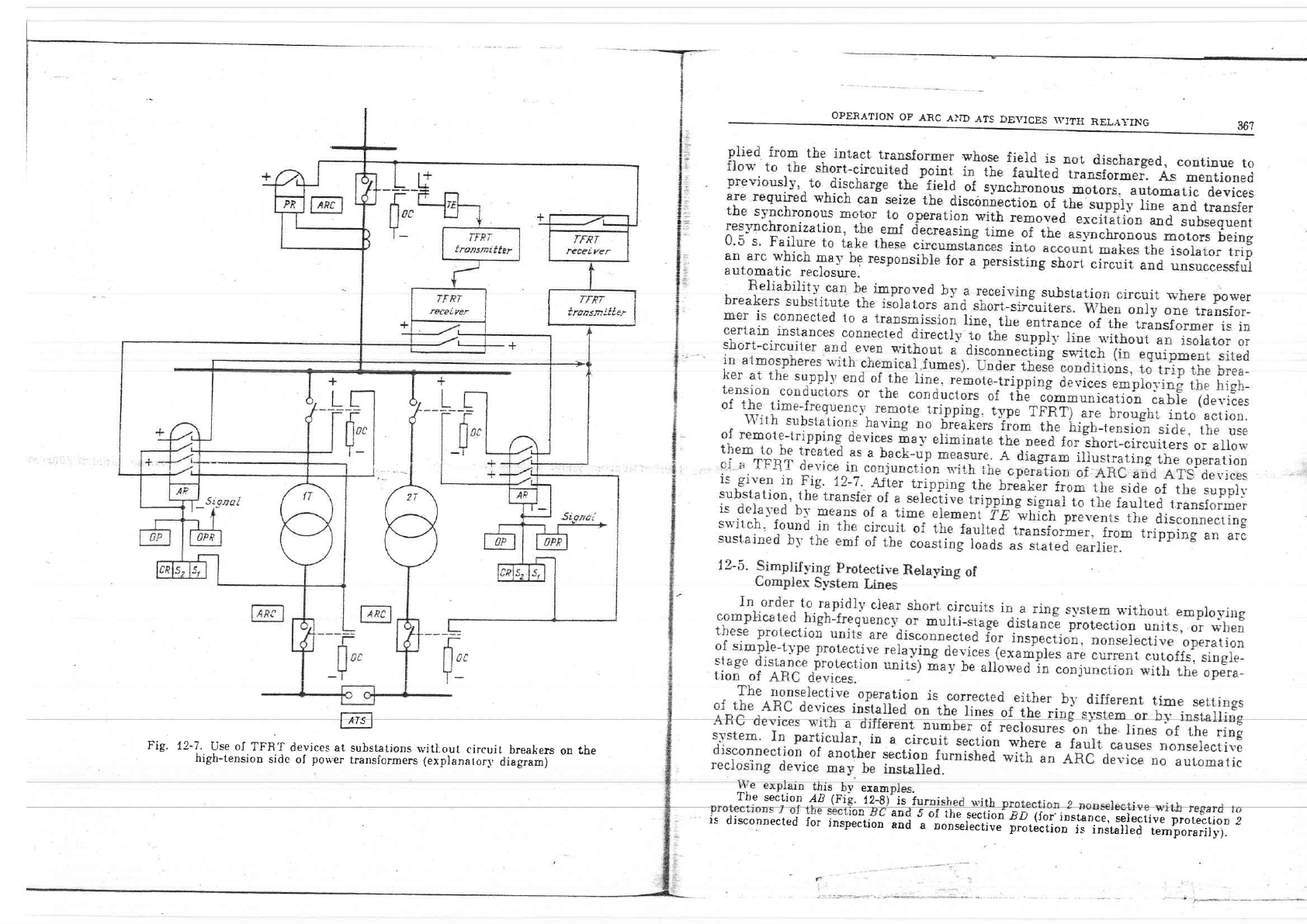
OPERATION
OF
ARC
A}ID
ATS
DE\TICES
\\,I?H
REL.{-:-ING
367
@
12-7.
Use
oI
TFR'f
devices
at
substations
rvitl
out
circuit
breakers
on
the
high-tension
side
of
power
transformers
(explanarory
ai"grfit-
-- --
rn
[nts y
exam
The
section
AB
(Fi
12-8
is
fur
a!
5
of
the
sectiori
BD
(for'
instance,
selective
pr"i""tio"'z
protection
i-q installed
temporarill;1.
Fig.
is
disconnected
for
inspection
and
a
nonselective
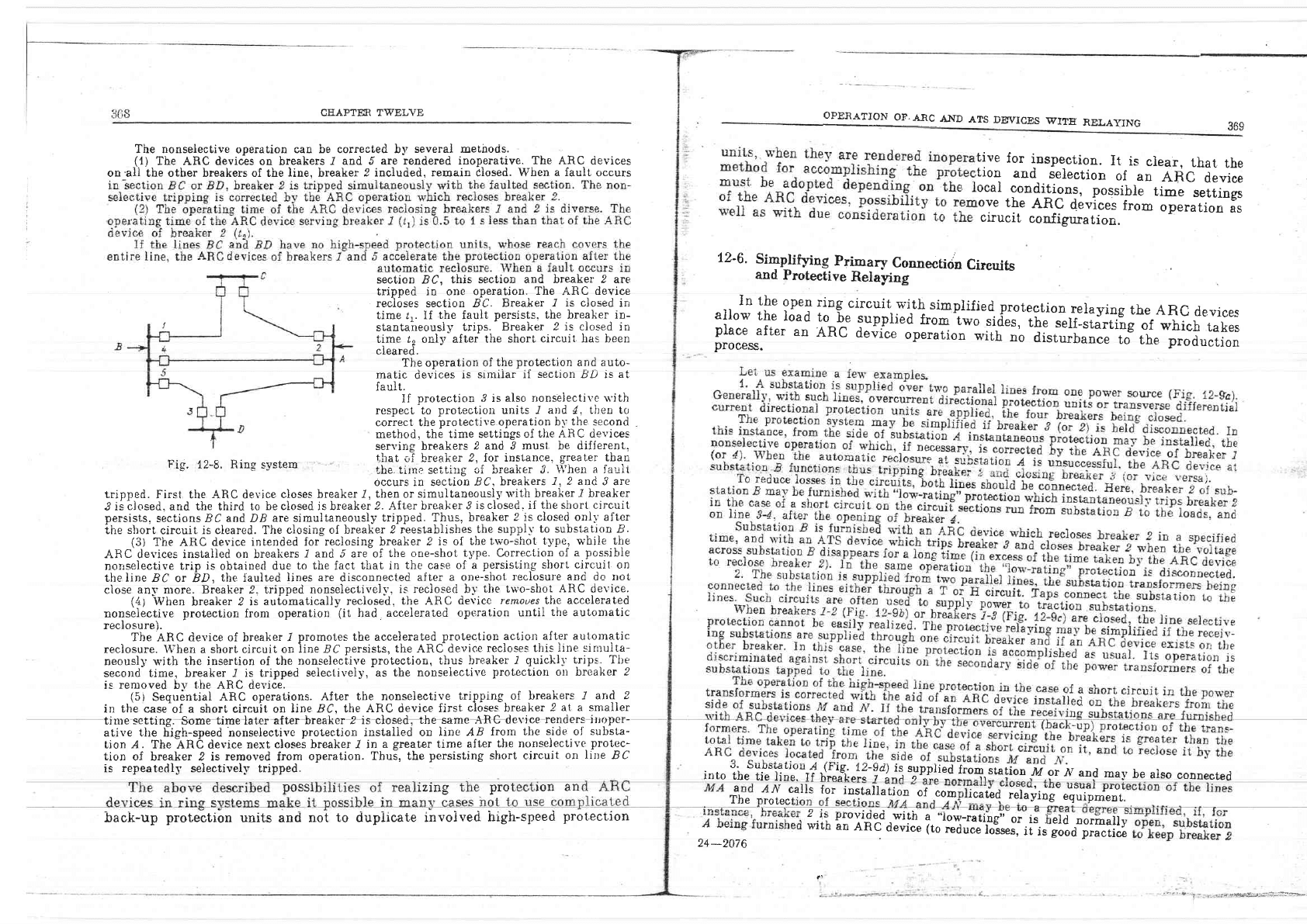
CEAPTER T'WELVE
The nonselective
operation
can be correcLed b]'
several metiiods.
(1)
The ARC devices on breakers J
and 5 are
rendered inoperative.
The ARC
devices
on'all the other breakers of the
line,
breaker
2 included, remain llosed. When
a fault
occurs
section
BC,
this
section and breaker 2 are.
tripped in one
operation.
The
ARC
device
recloses
section
BC.
Breaker
I is closed
irr
time ,,. If
the
fault
persists.
the
breaker
in-
siantaireousiv trins.
-
Breaker 2
is closed
in
time t, onl5z"s11.1
the shor!
circuit has been
cleared.
The operation
of
the
protection
and auto-
matic
devices
is
srmiiar ii
sec[ion
BLr is
at
iault.
If
protection 3 is also rronseiective
u'i[h
respect
to
protection
units .Z
and
4.
Lhen to
correct the
protective operation
b1- the second
method,
the time
settings of
the ARC devices
serving breakers
2 and
3 must, be difierent.
tlrat of breaker
2, Ior
insl,ance.
greaLer
than
tire-
tirne sei,tiug
ci breaiier
,i.
tr"hen a
fauli
occurs in section
8C.
breakers
l, 2 anC
J are
t,riptred.
First the ARC device
closes breaker
J, then or
simultaneousl5'ri'ith
breaker
J breaker
.3 ii
-closed.
and
the third to
be closed
is
breaker
2. Af
ter
breaker
3
is closed.
iI
the short circuit
persists.
sections BC and DB
arc simul[aneously
tripped.
Tlrus,
breaker
2
is
closed onll'after
i,he short
circuit
is cleared. The
closing of breaker
2 ieestablishes
llie
suppil' to subst.ation ^8.
(3)
The
ARC
device intended
for-reclosing breaker
2 is
of the
trvo-shot
type, v'hile the
ARC deyices instaiied on brealiers
J and .i are-of
the one-shof
type. Ccrreclion
ol a
possible
norrseiective
trip is
obtained
due
to the
fact
tliat in
the case
of a
persisling short circuil
on
the line
BC or BD,
the
laulted
lines are
disconnected
after
a one-shot,
reciosure and
do
rrol
close
an-v more. Breaker
9.
tripped
nonselectivel
5,.
i. reclosed b1'the
two-shot
ARC device.
(41
When
breaker 2 is
auiomatically
reclosed..
the ARC
devicc
renrooes the accclera[ed
lonselective
protection
from operation
(it
had.
accelerated operation
until
the autontatic
reclosure).
The
ARC device of breaker
i
promot,es
the accelerated
protection
action after
automatic
reciosure. \4rlien a short circuit on
line
BC
persists,
the ARCdevic,e
recloses tliis
line sinulta-
neousll'
n'ith
the insertion
of the
nonseleciive
protection,
thus breaker
/
quickli'
trips- Tlie
second time, breaher J is
tripped
selectivel-v, as the
nonselective
protectioti
ott breaker
2
is
removed
by
t,he ARC
device.
(5r
Seouential
ARC
operations.
After tlre nonselective
tripping
of bre.akers I
and 2
in
the
case^of a short circuit on
line BC, Lhe
ARC
device
first
ci'5seibreaker
2 al a
smaller
tj rne
setting.
Some
time
Iat,er
after breaker 2
is closed,
the samc
ARC device
renders ilropcr-
ative t,lie
Eigh-speed
nonselective
protec.tion
instalied
on
linc AB
flom
tlrc
side
oJ'substa-
Lion A. The
ARC device
next
closes breaker I in
a
greater
time
after
the nonselec[ive_
protcc-
tion
of
breaker
2 is removed from
operation.
Thui, the
persisting short circuit
on
line.BC
is
repeatedl5'
selectively
tr1iOO*U.
tive
for
inspection.
It
is
clear,
that
the
tion
and
seiection
of
an
ARC
a""iw
ocal
conditignl,
possible
time
settings
ove
the
ARC
devices
from
operation
i's
cirucit
configuration.
12-6.
Sim4if.nog
Primary
Connection
Cireuits
and
Proteetive
Relaying
In
the
opetr
ring
circuit
with
simplified
protectiou
relaying
the
ARC
devices
allow
the
load
to
ie
t"pfrita
T*t
-t*o
gr.,i".,
tie
seti-srarring
of
which
rakes
place
after
an
ARc
device
opttrtioo
u,ith
no
-disturbance
to'
the
production
process.
OPERATION
OF.ARC
AND
ATS
DSVICES
'W'ITE
RELAYING
into
"tl""iie.ii,1,"1"rf
,ll,f;ii
y"li:
rlqtiiT-from,starioo.M
g.
y'/
and
ma-v
be
also
oonnecred
a
,{,&
calls
for
installation
of
com
:_--J
rY-vwu, _
uue
uDudr
Pl-u
L
rcar,ed
relaying
eguipment,
?AO
Fig.
12-8.
Ring
systern
I
possl
rzrng
pro IOn an
The
2
is
provided
with
with
an
ARC
device
eld
.norfoaily
good
practice
back-up
protection
units
and
not
to
riupiicate
invoived
irigh-speed
protection
24-2076
rotec
a
"low-rating"
or
is
j
(to
reduce
losses.
it
is
'?r_!
i_
rr -
---.{rit,F.!€€sgri::.-3jk
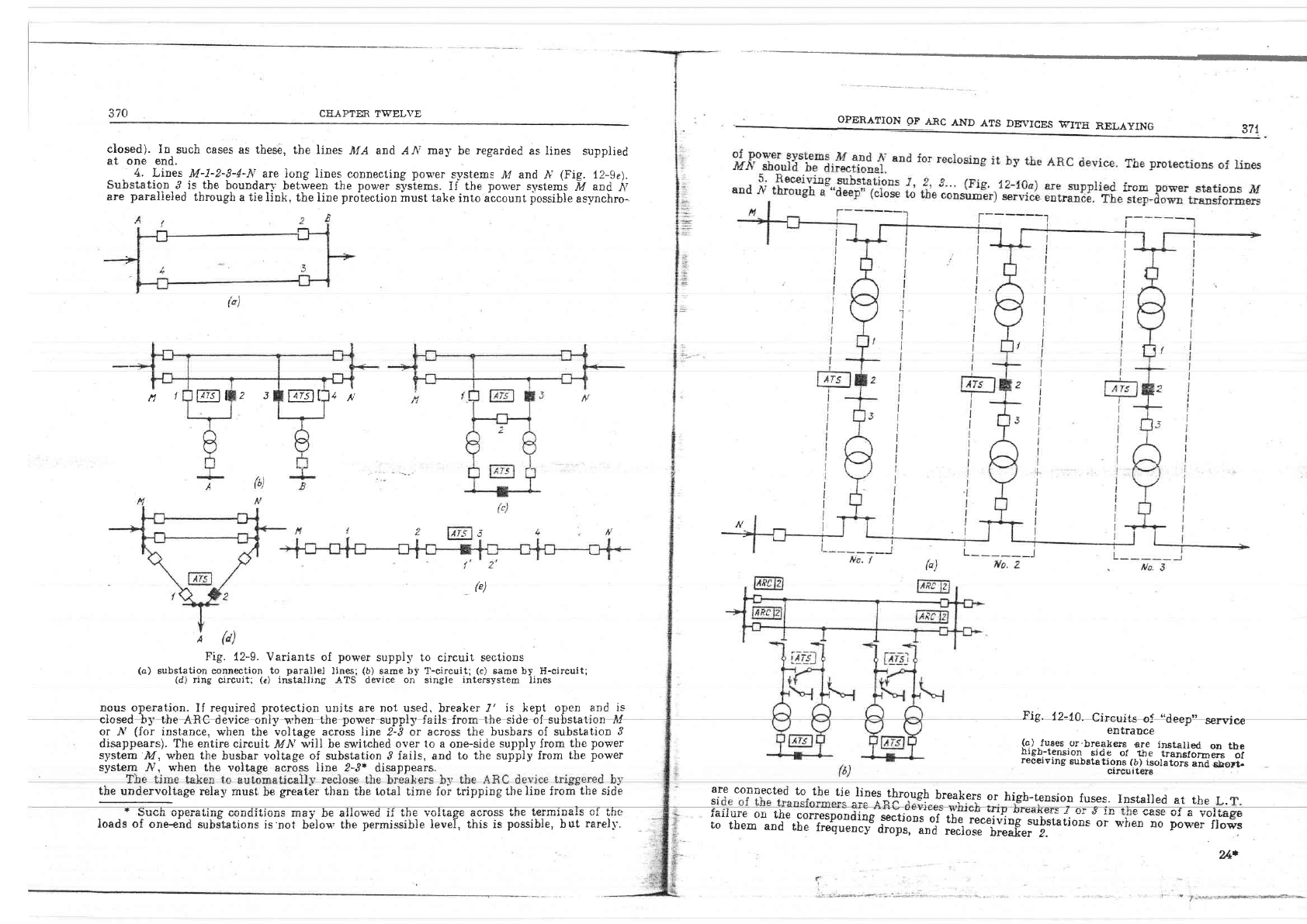
370
CEAPTEA.
TWELVE
OPERATION
OF
ARC
AND
ATS
DE\iICES
WITIi
R.ELAYING
371
closed).
In-such
cases
as
thes6,
the Iines
It{A and.dr\; ma1'be regarded
as lines
supplied
at
one end.
4.
Lines
M-i-2-3-4-Ir
are iong lines
c,onnecting
pov'er
s],stems
M
and
,[
(Fig.
I2-ge).
Substation
3 is
the
\oundary
betrieen
the pou'er
sj'siems.
if tbe
polver
svstems
.ir'
and
,A'
are
paralieled
through
a
tie iink,
the line
prolection
must tal<e
into account
iossible
asynchro-
tl
1
tTrTl
I
IEIt
4*'
Fig. 12-9.
Variants of
power
supply
to circuit
sections
(o)
substation
connection
to
parallel
lines;
(b)
same
by
T-circuit;
(c)
same by H-circuit;
(d)
ring
circuit;
(e)
installing
ATS device
on
single
intersystem
lines
nous operat.icrn.
If required
protection
units
are not used.
breaker
J' is hept open
and
is
closed
by the ARC
device only
q'hen
the
power
suppll'fails
from
the side of substation
/ly'
or,Ai
(for
inst,ance,
when
tbe voltage across line
2-3 or
across
ti:e busbars
of substation
J
disappears).
The entire circuit
i/.[
will
be
switched over to a
one-side
supply
from
tbe
power
systern
M,
v,hen the
busbar
voltage
of substation 3 fails, and
to the supply lrom
tbe
power
system
y'y',
when the voltage
across
line
2-3* disappears.
the
undervoltage relav
must
be
greatbr
than
tbe
total
time foi
tripping tbe
line
frori-the
sidi
are
connected
to
tbe
t-,:
I:r^r-tltough
brea,kers
or
high_rension
fuses.
installed
at the
L.
SI
(")
Fig.
t2-10.
Circuits
of
,,deep"
service
entrauee
(o),fuees
.or.breakere
are
installed
on tbe
rugn-lenston
6lde
of
the
translormers
of
receiving
eubsts
tions
f
a) isolatoil
A;d
;i";:
circuiters
.
.
laiiure
oa
the
conesponding
to
them
and
the
fresuencv
rrvv,
wurv!
Lrrp
ur_efl!{ers
I
oI
J
Ln
sections
oJ
tbe-
receiving
subsGiions-or
orops,
and
reciose
breaker
2.
e
case
vr
o
yur|,aEu
power
flows
+
Srr^h ^na-^*l-.- ^^-i:.:^*^ -^-- L^ -Il^---^J :I +L^ ,.^l+-^^ +ha +^nrnih6lc ^{ +h.
uuuu
vPEralrtrB uurJur!tul.l-\
trtaJ
lrts uttu$,Eu
tl
LlrE vurLdxE dvrvDD
errc
uElrrlruqro
r,1
lrrL
ioads of
one-eird subitations
is'not
belou'the
permissible
}evei, this is
possible,
but
rarell'.
Wlren
nO
24+
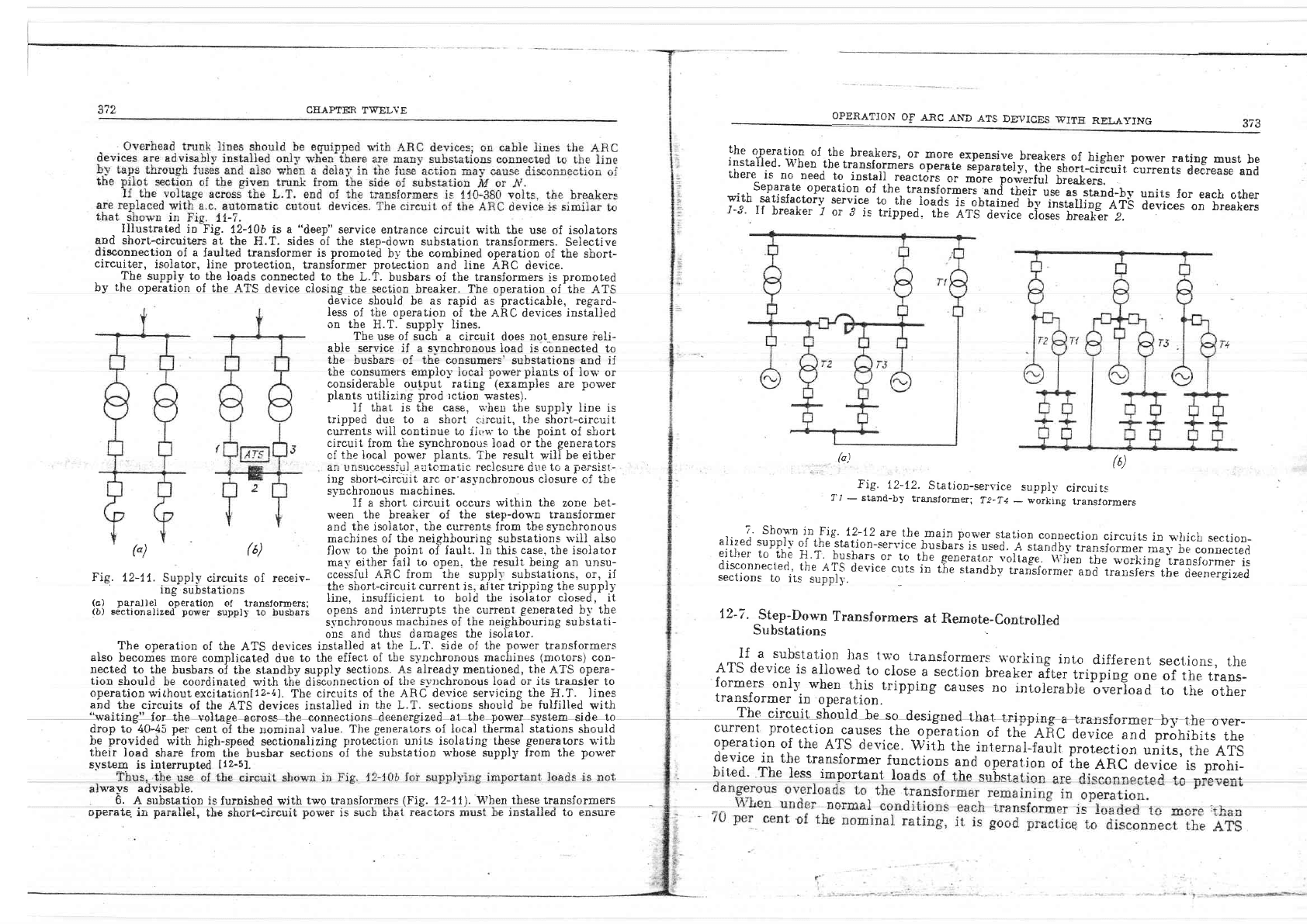
Illustrated
in Fig.
72-70b is a "deep"
service entrance circuit
with tbe
use of
isolators
and
short-circuiters
at the
H.T. sides 6l the
step-dov'n substation
transformers.
Selective
disconnection
of a
faulted transformer
is
promoled
b-v the combined
operation of the
short-
circuiter,
isolator,
Iine
protection,
transiormer
prot-ection
and ]ine ARC
device.
. .Tht
supply to the
loads
connected to
the
L.t. busbars of tbe
transiormers
is
promoted
by
the
operation
of the
ATS device ciosing
the section
breaker. The operation of-the ATS
device should be
as
rapid
as
practicable,
regard-
Iess
of the
operation of the
ARC devices
installed
on tbe
H.T.-suppll' lines.
The
use
of
such
a circuit
does not ensure ieli-
able
service
if a svnchronous load
is
cbnnected
to
ihe busbars
of
ihe consumers'
substations anti
if
aL- -- - ------l-- I --l -- --l , .1
rtre
cotrsulllers eurProv
rocar
power pran[s
oI IoE' oI
considerable output ratins
(examples
are
power
piants
utilizing
liod
rction-wastes).'
If
that
is the
case,
ri'hel
the supply line
is
trinped
due
to a short
circui!.
the
short-circuit
curr'ents u'ill continue to
iit,u'
to tbe
point
of sliort
circuit
from tire synchronous
load
or tbe
generators
cf
the locai
power plants.
The
result
will
be eitber
an
unsuccessiul.
at:'uamatic reclcsr:re
due
to a
pe,isist-
ing
strort-circriit
arc oilas*ynchronous closure
of
the
syncnronous
II]acnlnes.
IJ a short circuit
occurs
within the
zone
bet-
l'een
the
breaker of
the
step-down
transf
ormer
and
the
isolator,
the
currents
fiom
tbe
synehronous
machines oi
the neighbouring
substations
rvili also
flou'
to the
point
of faulr. Irr
this
case.
tbe
isolator
ma1'
either iatl
to
open. the resuit being
an
unsu-
cceisfui ARC from
ihe
suppil'
substations.
or, if
the
short-circuit
current
is, alter
tripping the suppll'
Iine, insufficient
to bold the isolator closed, it
oDens
and interruots the current
generated
bv
the
synchronous
machi'nes of the
neighf,-ouring
subitati-
ons
and
thus
damases
the
isoiator.
JIL CEAPTER'
T'WELVE
(6)
systerq
is ilterrupted
[12-5].
s'ays
6.
advisable.
A
substation
is furnished with
:* -^-^ll^t rL^ ^L^-e ^:-^--:4
lu
Pdr
iarrlir,
lurt tltul tr'-(;ll'-trul t,
(")
Fig.
L2-11. Supply
circuits
of receiv-
'
ing
substations
(a)
parallel
operation
of transformers;
(b)
Bectionalized
power
supply
to
busbars
The
operation of tbe
ATS
devices
instalied
at the L.T. side
of
tbe
power
transformers
al-"o
beconies more complicated
due
to the
effect of
tbe
s-vnchrorrous
maclin"s
(motors)
cor-
nected
to the
busbars
oi tbe standby
supply
sections. As
already
mentioned,
the
ATS opera-
tion
should
be
coordinated
s'ith the
diiconrrection
of
the s-\iiiclrrorious ]oad or iis iranster
io
operation
wi(houtexcitationf12-a].
The
circuits of
the
ARC device
servicing
the
H.T.
lines
aiid the circuits
of the ATS
devices
installed
in
the
L.T.
sections shouid
-be
tulfilled
with
"waiting"
for
the
voltage
across
ihe eonnections deenergized
at the
power
system
side
to
drop to-40-45
r,er cent
oi
the
nominal
value. The
cenerat6rs
<if lc,cal thermal siations
should
he
|rovidea
wittr high-speed
sectionalizirrg
proteciion
units
isolating these
generetors
v'ith
their
load
share
from tde
busbar
sections-oi
tbe substation
u'bose
iuppll.fiom
the
po$'er
ulJsr
q
!s.
two translormers
(Fig.
72-11\.
When these transformers
:^ ^..^L
+L-r
-^^^+^-^ .*-.^+ L^:--+-ll^l 4^
^-.^rti^
PUWEI
l)
DUU!
l,lrdt
lEdUlViD
IUUDI
!E llDKllgu
LU EuDus
de'ice
in
the
transformer
functions
aDd
op*ruUoo;i
il;;i[1#il'#';";ii
bited.
The
less
important
loads
of the srrirsta{i^. o.o rrt ic^^--^-*ar +^ b-^--^-4
oPERATION
OI
Anc
AND
ATS
DEVTCES
.WITE
RELAYING
o/o
the
operation
of the
breakers,
or
more.
expensive-
breakers
of
higher po\r,er
rating
must
be
installed'
14'hen
the
transfor-Lti-"pl.*te
separateiy,
!h-e
short-cireuit
currents
deerease
and
there
is
no
need
to.
instail
r"""i.i"i
o.
*6ru
po#.rtur
breakers.
Separate
oneration
of
the
transforme".
'"nd
theii
use
as
stand-by
units
for
each
other
Trith
$tisfactoiv
service-t"
it"
lolas
is
obiained-i-o'i*t"tting
ATlq
de*ices
on breakers
j-J.
rr
breaker'r
or
J
is tripped.-i[=.
erlr;;i*;i"ffH;;-k?r"i.-
sL"u'
(qt
ft)
Fig.
L2-72.
Station-sen'ice
suppll,
cjrcuits
irJ
-
stand-bf,
tra'Isformer;
T2-T4
_
working
transformers
7'
Shou'n
in
Fig'
72-72
arc
the
main
power
station
connectjon
circuits
in
rn'hich
section-
alized
supDh'
of the"station*serviie
b";b;.;ii
"..J1e
lt"'iab.1'
t"urrrformer
ma5,
he
connecte6
ejLlier
to't'bi
H.T.
trushai.
o. t""trr!-generator
uoii"gl.--ia']ren
the
v",orliing
transforrner
is
disconnect'ed.
the.4TS
device
cuts
in ti.
ii*rany"t""l"ror"rrt;"d
tr;;;i"i"tt
"
deenergized
sectjons
to
its
suppl5..
12-7.
step-Dor*'n
Transrormers
at
Remote-controiled
Substations
..
If a
substation
Jras
two
transformer-"
u'orking
into
different
sections,
the
ATS device
is
allou'ed
t.o
close
a sectjon
breaker
a?ter
trippins
one
of tlie
trans_
formers
onilz
wfusn
this
tripping
causes
no
into]erlbi;';-drjJo"J
r,o
rire
orher
transformer
in
operation
The
circuit
shouid
be
so
designed.
tlrat-tripping
a
transformer
by
the
over-
cuffent
protection
causes
the
operation
of ttre'enC
device
"na
prohibits
the
operation
of the
ATS
device.
With
the
internal-fault
protection
units,
the
ATS
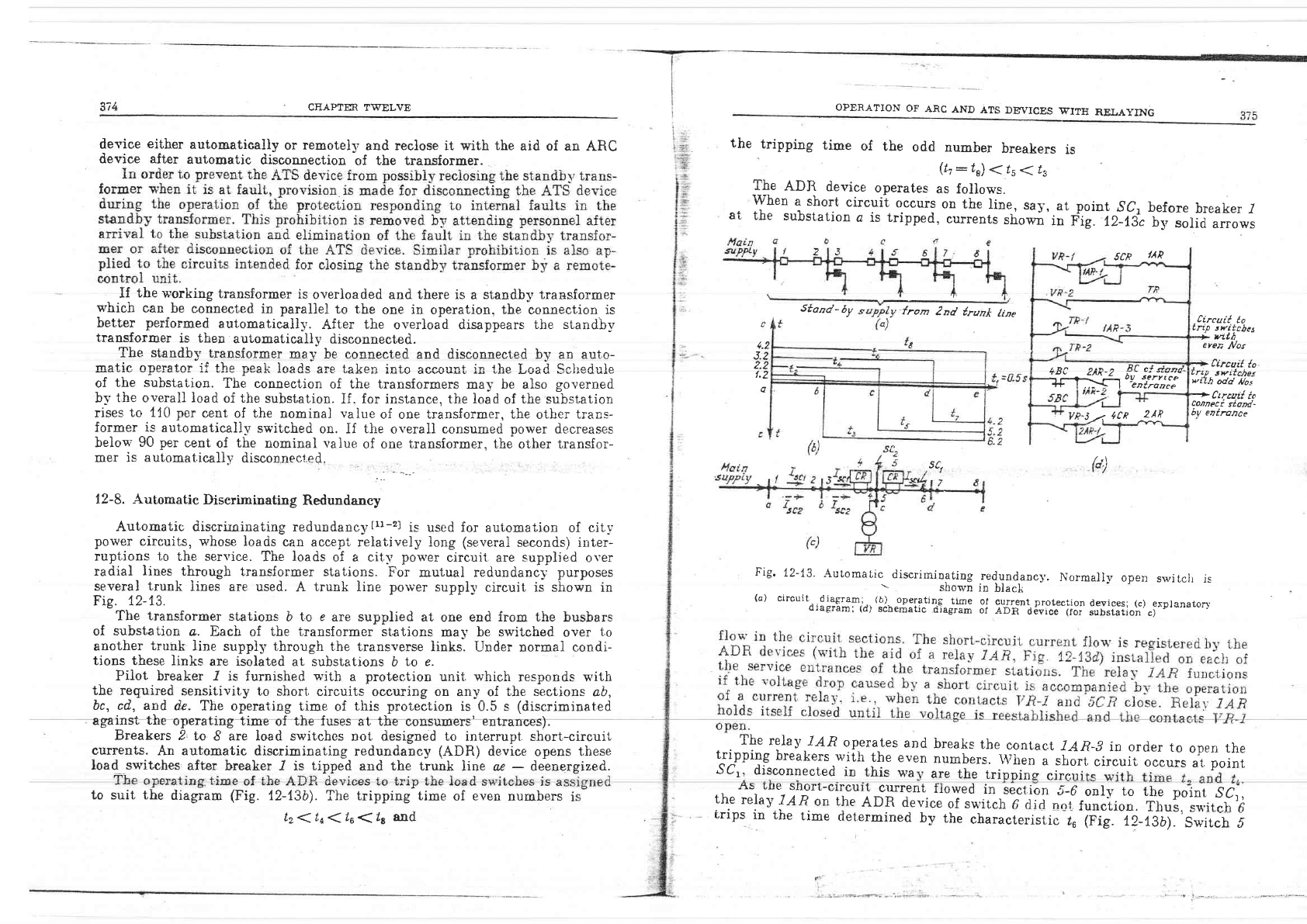
otl
CEAPTER
TWELVE
OPERATION
OF
ARC
AND
ATS
DSVICES
'WITII
RELAYING
device
either
automatically
or
remoteil'
and reclose it with the
aid of
an ARC
device ajter
automatic
disconnection
of
tbe transformer.
If
the
u,'orking
transformer
is
overloaded and there is
a
standby transformer
which
can
be
connected
in parailel
to the
one
in
operation,
the
connection is
better
performed
automatically.
After
the
overload disappears the
standb-r'
transformer
is then
automaticaliv
disconnected.
The.
standbv
transforrner
*rv
b*
c.onnected. and disconnec.te.d bv an auto-
J-
rnetir. nncref.nr i{ f.ho npaL'lnodc
qro
foLon infn oacnrrnf in'tho T..,o.l Q.},ar{rr'lo
vrJe pvqrr
luUv
qvvvuuu
ru LIrv
Uvqu vvrrvuutL
of
the Jubstation.
fhe
connection
of the transformers
ma-v be also
governed
by
the
overail load
of
the
substation.
If. for instance, the ioad
of
the substation
rises
to
110
per
cent
of
the
nominal
vaiue
of one
transformer, the
other
trans-
former
is
automaticallS'switched
on. If
the
overall
consumed
porver
decreases
below
90 per
cent
of
the
nominal value
of oue
transformer, the
oiher
transfor-
mer
is automatical]v
disconnec't,ed.
'..--
12-8. Automatic
Discriminating
Redundancy
Automatic discrirninating
redundancl,[r1-z]
is
used for
automation of city'
power
circuits, whose loads
can accept
relatively
long (several
seconds)
inter-
rupt.ions
to
the
service.
The
loads
of a cit,y
po\ver
circuit
are
supplied
over
radial
lines
through
transformer stations.
For
m.utual redundancl'
purposes
several
trunk
lines
are used.
A
trunk lirre power
suppl-v
circuit
is sirown
in
Fig. L2-73.
Tire
transformer
stations
b
to e
are supplied at
one end
from the
busbars
of
substation
a. Each
of
the transformer
stations
ma]'be
switched
over
t,o
another
trunk
line
suppiy
through
the
transverse iinks.
Under
normal
condi-
tions these
iinks
are isolated
at substations
b
to e.
Piiot breaker 7
is furnished
s'ith
a
protection
unit
which
responds with
the required
sensitivity
to short,
circuits
occuring
on
any of
the -sections
ab,
bc, cd, and
de. The
operaiing time
of
this
proteciion
is
0.5 s
(discriminated
against
the
operating time
of
the fuses
at the
consurners'entrances).
Breakers 2
to
8 are
load
switches not designed
to
interrupt,
short-circuit
currents.
An automatic
discriminating
redundancy
(ADR)
device
opens
these
Ioad switches,after
breaker / is
tipped
and the trunk
line a,e
-
deenergized.
to suit the
diagram
(Fig.
12-\3b).
The tripping time
of
even
numbers
the
tripping
time
of
the
odd
number
breakers
is
(tt:te)(fs(ts
The
ADR
device
operates
as follows.
When
a short
circuit
occurs
on the
line,
sa5,
at
at
the
substation
a is tripped,
currents
showi'in
Stand-
6y
from
?nd
drun.I
ltne
point
8C, before
breaker
I
Fig.
12-13c
by
solid
arrows
'CR
tAP
tircuil
to
trtp
sviicbes
->
VLE0
F/
eyen
./{os
77
Circaii.{o
Lrzp
srrLtches
y,iLh
odd
//os
+&rmi./
ia
conneci
slond-
by eatronce
open
the
at
point,
Fig'
12-13.
Aulomatic
discrirninating
redundancy.
Norma]ly
open
sg,itclr
is
(a)
circuir
o:lq3pj,,
rg2-.-9gg1g^ti1;tiJ:
T
if$r
proteciion
devices;
(c)
expranatorl.
diagrarn; (d)
scheriatic
aiaglam
oi
;-Dri";#ice
(ro,
substatjon
c)
The
rela5,
lAR
operates
and
tripping
breakers
with
the
even
breaks
the
conta
c.L lAR-S
in order
to
numbers.
\\zhen
a short,
circuit,
occurs
.SCr,
disconnected
in
this
wa
are
the
trippins
circui
/ls Lre
snort-crrcurt
current
flowed
in
section
5-6
the
reiay
lAR
on
the
ADR
device
of su,itcir
6 did not
onlS'
to
tiie
polnt
.9Ci,
function.
Thus,
su'iteh
d
(Fie.
t2-13b).
Switch
J
1.2
,1 ?
2.2
t.2
q
/. D^ Rf ai tn-)-
iffiii',;"'iiii!f
VR-|
z
4CR
zAR
cr
tzlta
(
fo
(
Ir and
irips
in the
time
cietermined
by
the
characteristic
I^

CEAPTER
TWELVE
OPERATION
OF
ARC
AND
ATS
DE-\IICES
WITE
RELATING
.i6
:lg
3'
A-fter
distance
connection
the
accelerated
protection
time
should
be
e
raised
currents
resuiting
from
starting
place.
makes
it
possible
to
achieve
radial
supply
ply.
The
sectionalization
of the
srrbstatioo
rr€nts,
thus
facilitating
operation
of
the
L
construction
costs.
ices
must
be
coordinated
with
the
appro_
vices
of the
actuators
of
the
asl,nchronous
tic
devices
helping
res_vnchronization
of
.,
slfichronous
motors.
=
6'
The
combined
urq
of
isolators
and
ARC
devices
in place
of
circuit
brea-
kers
should
take
into
.
ccount
the
t-vpe
of
toaas
""a,-i"'p^r{,icular,
the
fact
that
after
deenergizing,
tlie
ioads
continue
to
maintain
for
some
time
the
ter-
-
-
minal voltaoe- This i" oenoniollr' +-,,^ ^r ^ ^--^r--- r t
_ _ __D_
^v
vsyvvtqrrf
!r uE
rrl
a
Dyucruoltous
loao,
is
tripped
b-v
its
ADR device
in time
ts.
This
is done
by
the time
rela_v
?fi
(by
the
contact
TR-z
whose
circuit is not
eontrolled bv
tbe contacts
of relav
1An.
Tbe
breaker
of
the
reserve
service entrauce
is
closed bv
the
ADR
device
when
one of
tbe
service
entrances
of
the
main suppl5'trunk
line is disconnected
(even
or odd, Fig.
12-13d;
and the service
entrance
of
the reserve suppiy
(cont-
rohed by the
auxiiiary
contact
BC of
the
reserve service entrance
breaker)
and the contacts
2AR-2
or
LAR-Z
are closed
The
contaet lAR-2
of. tbe
ADR
devices
of
the
breakers
in the
circuit car-
'
ryrng
'rhd
short-circuit
current closes.
Ciosed
is the
contact
2AR-2
in
the
ADR
devices instailed
in
the
main supply
trunk
line
sections
s'hich
carry no short-
circuit
current
(the
relay 2AR
functions and
breaks
the
contact 2AR-2. if the
eontacts
of
voltage
relay
VR-? and
current, rela;'
4CR
are
ciosed). A-fter
the
current
flow
stops,
the
relay 2AR holds
itself
closed
with
the
contact
zAR-l
until
the
voltage
is
reestablished.
Thus,
the
ADR device
discriminatingly
trips
the faulted section
s'ith
the
aid
of
the ioad
ss'itches
(u'hich
are. not, intended
for interrupting
short-c.ircuit
currents)
subseguently
changing the
load to the suppll'from the
reserve
trunk
line.
\\7hen
a short-circuit,
occurs
on
the busbars
of
tlre
tran-sformer
-substaticln
(for
instance, at
point
SCr),
the short-circuit
c,urrent
fiow, untii
the
instant
breaker
f trips.
is deterrained
b;' the broken
arrows
(Fig.
t2-13c).
This
differs
from
tbe
case of a short
circuit
at
ocrilt, S'C,-{considered above)
in
tiiat. no *qhort-
circuit
currenf flou's
in section
5-6. Therefore. the
relal' 5CR in the
ADR
device
of
switch 5 does not
function.
the
relaS /,4.,R
does not operate
and
the
contact
IAR-7
remains
open.
Since,
v'ith
a short
circuit at
point.SCr,
the rcLay 4CR
functioned,
the
contact
2AR-2
would
be opened in time
t5
at the moment sv'itch
5
opens. The load
switch
of
the reserve
service entrance
of
the
substation
c
wiII
not be able
to
close.
The
fauited
busbars
will
be
-tripped
open
b1.
switch
3
in
time lr.
The deenergized
substations
b,
d
and
e
would
be automaticaliy
trans-
fened
to a
reserve
trunk
line
suppll'.
The
automatic
discriminating
redundancy
method causes
long interruptions
to
the service,
a
fact
which
is
the
main disadvantage
of
this method of
trip-
ping
and reserving
the sections v'hen
they
are man-v
in
number.
12-9.
Conclusions
_
{.
In manrr
instances, the
combined
operation of
the
protective
relaf
ing,
ARC
and
ATS makes
it
possible
to clear
short
circuits ulore
quicklv, widen
the
fieid of application
of
''the
ARC and
ATS
devices
and high-speed
simpie
type protection
units.
2.
It
is advisable
to use
protection
acceleration when
high-s d
protection
for
protection
acceleration
before and after the aut.omatic reclosure.
-^^l^^,,-^^ ^-^ -^^-:.I.l^ +^^
I
EUIrJDLT.T
gC
O,I
E
I,I,DDIJJIE
IJ('IJ.
possibilities
of
simpiifS'ing
protective
relaying
cievices
r-hen
ATS
the
supply
is
the
ode-end
i"di"l
ijp"
*.
compared
to
the
ring
power
i2-i0.
Review
Questions
1.
Enumerate
the
devices
are
applied
and
supplv
svstem-
faulted
section
be enzured
b5,
comb-
of nonselectiv;:
protective
rilal,ing?
6. \4rhat
are
ttre
phenomena
which,
v,ben
taken
into
account,
limii
the
po..iliti'ti"s
ol
acce_
lerating
the
proreci.ion
operaiifi;ffi;L"
function_
ing
of
an
ATS
device
inst'Ctt.rl
""
rr,"
*"ir^-
hF^.1-^-
ing
of
an
ATS
device
inst'attea
on
*u
-."iioo
breaiier
of
a
substation
in tbe pre*sence
of
asyncirronous
and
synchronous
loads?
provide
Flr*ho. cim-la
carrran*i^l arr*a*a*ia
er4lrrv
DvYuesllql
ouuurltqllv
tc
teatures
of
ATS
devices
used
at
remote-controlled
substations?
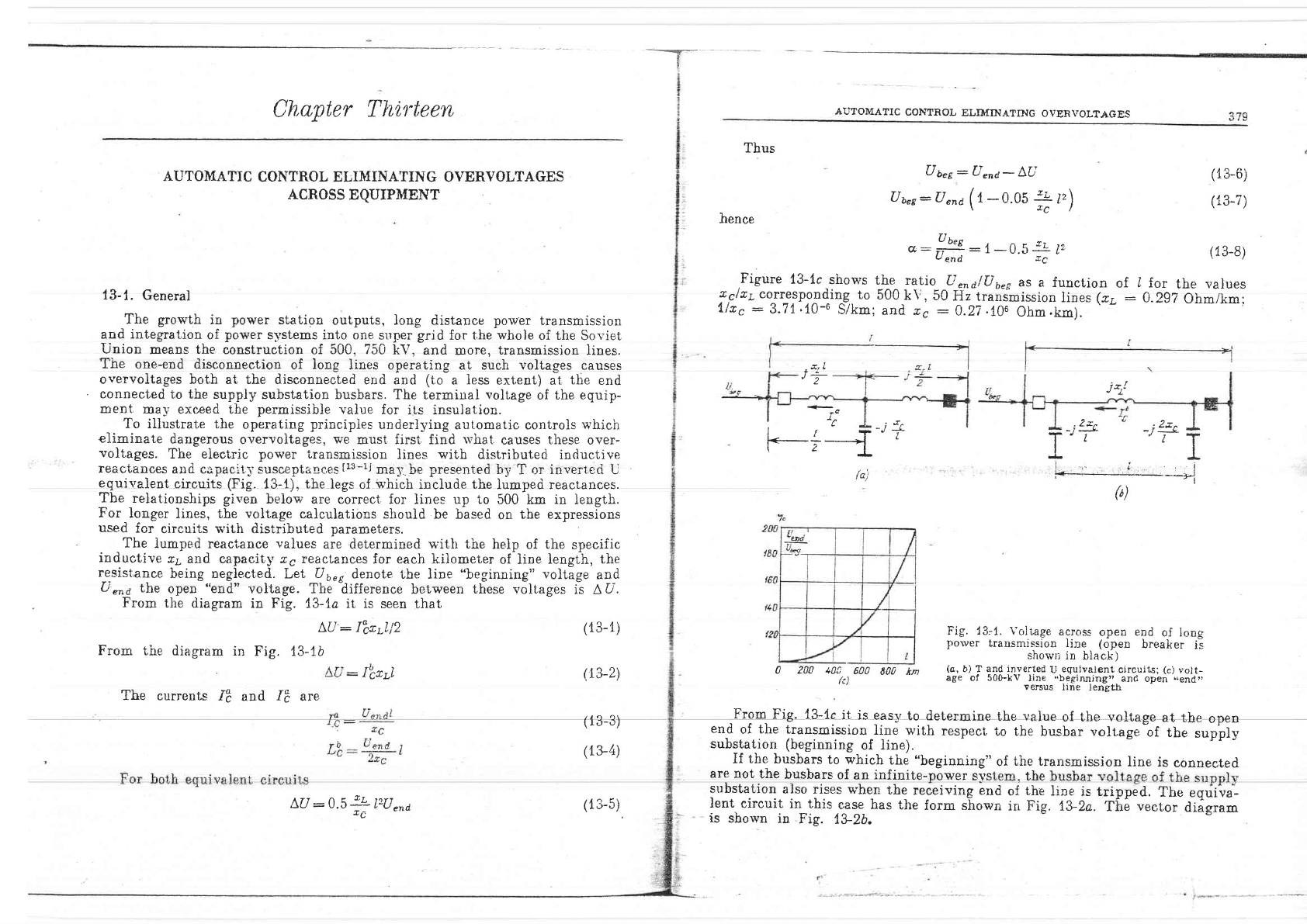
r
Chapter
Tlzirteen,
AUTO}{ATIC
CONTROL ELIMINATING OVENYOLTAGES
ACROSS
EQUIPMENT
13-1.
General
The
growth
in
power
station
outputs, Iong distance power
transmission
and
integration
of
power
svstens into one
srrper
grid
for
the
whole
of the
Soviet
Union
means
the
construction
of
500. 750
kV,
and
more,
transmission
lines.
The
one-end
disconnection
of
iong
lines operating
at such
voltases
causes
overvoltages
both at the disconuected
end and
(to
a
less
extent)
at
the
end
'
connected to the
suppiy
substation busbars.
The termiuai
voltage
of the
equip-
ment
ma]' exceed
the
permissible
value
for
its insulation.
To illustrate
the
operating
principles
underlyiug
automatic
controis
which
eliminate
dangerous
overvoltages,
we
must first find
rvirat
causes
these
over-
voltages.
The electric power transmission
lines
with
distributed
inductive
reactances
aud capacit;i'susceptanc,es[13-iJ
ma1'be
presented
b-l,T
or
inverted
U
equirtalent
circuits
(Fig.
13-1).
the
legs of
which
include the
lun.ped reactances.
Tbe
relationships
given
below
are
correct
for
lines up
to
500 km
in
}ength.
For
longer
lines, the voltage
calculations should
be
based
on
the expressions
used
for
circuits
with
distributed
parameters.
The
lumped
reactance
value-*
aie
determined
u'ith the
heip
of
the
specific
inductive
rs
and capacity r,s reacLances
for each kiiomet,er
of
line
length,
the
re_sist,ance
being neglected.
Lel
U
urs
denote
the line "beginning"
voltage
and
U"n.a
the
open
"end"
voltage. The
difference
between
these
voltages
il AU.
From
the
diagram
in Fig. l3-1,a
it is seen
that
LU': I'czrl12
From
the diagram
in
FiS.
13-tb
AUTOMATIC
CONTNOL
ELIMINATING
OVERVOLTAGES
Thus
hence
Ub"E:U"na-LU
fJb"s:U.^d
({
-0.05
#
*)
(13-6)
t!12'7\
\rd-r,l
(13-8)
for
the values
0.297
Ohm/km:
":#-i_a.s:Ltz
.Figure
t}-Lc-shon's
the ratio
[.t"n6/[.)6"n
as
a function
of
I
?glr"
coJr_elpgl{itq.
to
500
k\;,
50
IIz tranJmission
lines
(st
:
ilr"
:
3"71.10-6
S/km;
and
zg
:
0.27
.106
Ohm.kn).
*l
f
-:_
-2
ra
^t
I
t-i
r-
:J.
-r
-i-
:
1*^
't
-t
i-z. I
J-Z
i,'
'
,i"
-+
(t)
T
I
(aj
(13-t)
(.r3-2)
(13-3)
(r&'4)
(13-5)
0 200 40A
600
500 *m
tL/
Fig.
13,1.
Voltage
across
open
end
of long
power
transmission
line (open
breaker
is
showr.r
in
black)
(o,
b) T and
inverted
U
egulvalent
circuits;
(c)
volt-
age of 500-k\7
line
-beginning"
and open
sendl
versus
line length
The
currents
I"c
and
fE
are
.bt
I
6Iy-L
From
Fig. {3-1c
it is
easy
to determine
end
of
the transmission
line with
respect
suhstation (beginning
of line).
If
the
busbars
to which
the "beginning"
the
value
of the
voltage
at
the
open
to the
busbar voltage
of
the
supply
of
the transmission
Iine is
connected
are
not
the
busbars
of
an infinite-power
svs
substation
also
rises when
the
receiving end
lent
circuit
in
this
c.ase has
the
form s-hown
of
the
line
i-q tripped.
The
in Fig. L3-2a.
The
vector
the
equrva-
diagram
A{J
:0.,
*
IzU
"nd
is
shown
in
Fig.
13-2b.

CHAPTER
TEIIRIEEN
AUTOIUATIC
CONTROL
ELIMINATING
OVERVOLTAGES
381
The busbar
voltage
of the
supply
substation
is
Li
b"e
:
E
pn
-T
I
cLsust
li,
-tr
,
Uend't^
-'
oeE
-
"pn1-
4
LLaVst
,
Eph
,
Ueoc,
tsgst
l:F---F-::-L_-
Ub"E,
UbeE
zC
:L-
!
-pil
"u't
i.e.
Duee
'
Y"
zc
(t
y,"s)
E
pn
"
\Alhen tripping
the
open
}ong
lines
carrying
the generation.
the
of an
increase
in
emf
of
the
generator-"
(E;")
inoulti'
be
considered.
>ar
rvhen
a
long
transmission
line
is
connected
ne
is
disconnecled
at
one
end
the
reiationships
(+)
(ccl-"r*
xar/2):
(*)
+
(rlrb)
For
the
example
under
consideration
at
normal
freguency
the }ine
capacity
reactance
,.
0.27.106
ts/l:-=;--:540
Ohms
ot,
q-I
19
*O
tO? <nn
r4
-E ^l --
v.-!
t,
twltr
:
rJ
L,,IJIIIS
ui,,.
on
(kY)
.5052
""
:-Jl111a]-
zdc:
m.0.23
:
235
Ohms
transformer
iaduciive
ierclanre
,--u?-^.pn
$Y)
-
5052
"r:
-S-(MTE-
r".
:
-]t-.Cr.t2:121
Ohm_.
To
the
condition
of (13-i5)
corresponds
the
relationship
/ {t \2
Hence
\i )
Q3s+
121
+
75):
546
I / Etr,
ir:
l/
ffi:l,'T.ts:1.12
Thus'
for
this
exampje,
the
appearance
of selJ-excitation
is clearly
seen
u-]ren
the
gener-
ip-"":9-:*:r^fe-s
b1'f2
prri*i:b-o;ii,.
nomin"l
value,
i.e..
at the
freouencv of 5F, r{2.
",o'
io"".il":il::,fr.::
b;"il*:
,i",lif l* I,T
;d;iffrl,"Ti,l::
i".:,:1.;t,'?:&l;,"."'r,j,.#r:ff;.
Researchesshou.,
iio*eiie.r-ra+r;fi;;rff.,;jffi,i"i"lijli;
l,i;',t
u'"|i.ll?Hi.,lii:.%i,:ff;
ars
even
before
the
comptete
resonance
corrdition.
/49 n\
\
I'
J- i7i
(r3-10)
t42
'l,t\
\
rL'-r
r/
t42
,tcr\
\rd-1:/
( 1O- 1
l/
possibilit-v*
This
mav
linp inrlrra+irr6 raaa+^-^^
IYE
rEOW!dUCE
geDerator
inductive
reactance
k)
Fig-
13-2.
Caiculation
diagram (a)
and
vector
diagram
e n
d tri
p
p
i n
g
of
i
o n
g
p
orver- tra
l,s"*i
r,.i
"i
"fi::
rll"ii
sii n
ce
occur:
Jirst,
due
to
the
machine
acceieration
when
the
joad
is
discarded
(up
to
130%
for-hydroelectric
generators)
and,
second.
due
to the-
generator
self-
excitation
effect.
An increase
in
_the
generator
speed
raises
the
emf
of the
exciter
carried b1'
the
rotor
shaft
and
the
result
is
an increase
in
the voltage
".to*
the terminals
of
the
stator
u'inding.
,
Tire
self-excitation
ma1'
be..explained
in a
simple
s.a],
as
follov,s.
--, lnl:t_^?^igg_
transraission
Iine
is
tripped
"t-tlJ
t*""iving
end
and it
has
a
generaror
and
a
translormer
operating
as
a
unit
at
th-e
-suppi5,
end,
tbe eluivalent
circuit
*"i
lo
pr._
sented
h_v
the
-circriit
diagram
in
Fig.
IB-2a.^'
'
If
the
totai
inductive
reactance
o-f
the
circuit
becomes
equal
to
tl-.e
bapacitl
reactance
of tbe
line.
i.e..
if
(6)
(b)
for
of line
tbe
ease
of one-
and pou'er
st'-
appears
even
before
the
compr"te
lei-onail.'""i,aiiilii,l
(26
|
x7*
zfl/2):
a"11
t 4 2 4 /,\
trv-rr/
*,-q:"qili9,"^^oj^t.j9l"lce
arises
with
a
resultant
bear,]'current
flow
in
rhe
sraror
u'inding.
lines
with
one-errd
operation
the volta-
g
of
a
tie
line
or when
it
is
tripped
at
lrtialll'
compensate
for the
effeci'of
the
ection
of
reactors
at
both
ends
of the
,
costs,
reactors
are generally
connected
stations.
The
reactors
may
be
connected
r?o
ponrrimrl
i- ^-l^- 4^ -^l---^ rr-^ - r
^. ^ Ili:
"_I3l"i9_""nnot
be
eliminated
by reducing
the
e:icitation
manually
or b1'
means
*-lji:li_l'-.ry1.119t;
for the
current
flov'in.the
statii
circuit
is
maintainea
tir,rh;;-:;;;;;i
uragrrtsLruru
lrl Lrre
rrame
ano
pole pleces
ol the
nacbine.
j:fl:"._:t1+e
daTage
to.
t
-he
power
irandti"j
-equipmenr
of
\ rrlLI'UI
Ul
ltr9
OD/OII
SUtit.r.hino nnprof innc ^h +],o nnna{ ara
devicgs,
-------.'
wrvse
va uAe
rvauuurD
